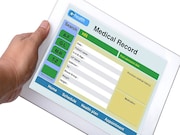Even after return to pre-EMR efficiency, more time spent on documentation, less on patient interaction
FRIDAY, Sept. 28, 2018 (HealthDay News) — Following a six-month learning period to implement an electronic medical record (EMR) system, outpatient orthopedic clinics return to pre-implementation efficiency, but there may be other lasting effects on productivity, according to a study published in the Sept. 19 issue of The Journal of Bone & Joint Surgery.
Daniel J. Scott, M.D., from Duke University in Durham, N.C., and colleagues examined the impact of EMR implementation using time-driven activity-based costing (TD-ABC) to evaluate the effect of EMR implementation in an outpatient adult reconstruction clinic. Researchers prospectively timed 143 patients throughout their visit to clinics, before implementation of a hospital system-wide EMR system and then again two months, six months, and two years after implementation.
The researchers found that total labor costs per patient visit significantly increased at two months after EMR implementation (from $36.88 to $46.04; P = 0.05). This change was driven by increases in the amount of time that attending surgeons spent with each patient (from 9.38 to 10.97 minutes, with the cost increasing from $21.10 to $27.01) and increased time that certified medical assistants spent assessing patients (from 3.4 to 9.1 minutes; P < 0.001). Although two months after EMR implementation, providers were spending more than twice as long documenting patient encounters (P < 0.001), by six months after implementation, total labor costs were similar to those before implementation ($38.75 versus $36.88; P = 0.689). These remained similar at two years after implementation ($36.88 versus $37.73; P = 0.84). Providers spent more time documenting encounters (8.43 versus 3.28 minutes; P < 0.001) and less time interacting with patients (10.03 versus 14.65 minutes; P = 0.013) following the initial learning period after EMR implementation.
“Health care systems and policymakers should be aware that the length of the implementation period is approximately six months and that implementation may alter the time that providers spend with patients,” the authors write.
Abstract/ Full Text
Copyright © 2018 HealthDay. All rights reserved.








